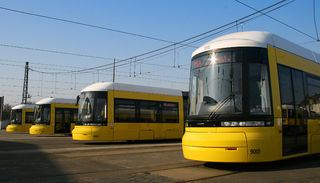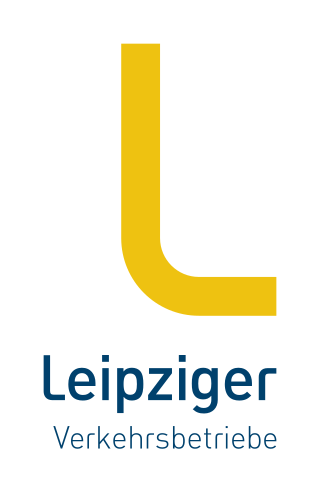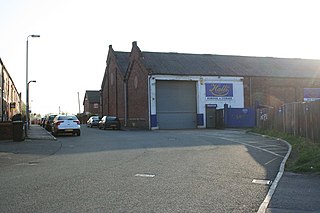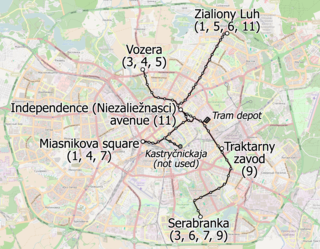There have been two separate generations of trams in London, from 1860 to 1952 and from 2000 to the present. There were no trams at all in London between 1952 and 2000.

The Berlin tramway is the main tram system in Berlin, Germany. It is one of the oldest tram networks in the world having its origins in 1865 and is operated by Berliner Verkehrsbetriebe (BVG), which was founded in 1929. It is notable for being the third-largest tram system in the world, after Melbourne and St. Petersburg. Berlin's tram system is made up of 22 lines that operate across a standard gauge network, with almost 800 stops and measuring almost 190 kilometres (120 mi) in route length and 430 kilometres (270 mi) in line length. Nine of the lines, called Metrotram, operate 24 hours a day and are identified with the letter "M" before their number; the other thirteen lines are regular city tram lines and are identified by just a line number.
Leipziger Verkehrsbetriebe GmbH operates one of Germany's largest tramway networks. The tramway network history is presented below in tabular form, including opening, electrification, and closing dates by segment. Street names of the time are used in the tables, with current names in (parentheses).

The Leipziger Verkehrsbetriebe (LVB), literally translated into English as the Leipzig Transport Authority, operates the tramway and bus transport services in Leipzig, Germany. The LVB network is a part of the regional public transport association, the Mitteldeutscher Verkehrsverbund (MDV). The LVB was formed by the merger, from 1 January 1917, of two predecessor undertakings, the Großen Leipziger Straßenbahn and the Leipziger Elektrischen Straßenbahn. The merged undertaking was also known as GLSt until it was reorganized and renamed as the LVB, from 29 July 1938.

Trams make an important contribution to public transport in the city of Zurich in Switzerland. The tram network serves most city neighbourhoods, and is the backbone of public transport within the city, albeit supplemented by the inner sections of the Zurich S-Bahn, along with urban trolleybus and bus routes, as well as two funicular railways, one rack railway and passenger boat lines on the river and on the lake. The trams and other city transport modes operate within a fare regime provided by the cantonal public transport authority Zürcher Verkehrsverbund (ZVV), which also covers regional rail and bus services.

The former capital of the Ottoman Empire was once served, on both its Asian and European sides, by a large network of trams in Istanbul. Its first-generation tram network first operated as a horse tram system starting in 1871, and was eventually converted to electric trams in the early twentieth century. The original tram network finally closed in 1966.

The Istanbul nostalgic tramways are two heritage tramlines in the city of Istanbul, Turkey. The city has two completely separate heritage tram systems, one on the European side, the other on the Asian side.

The Bern tramway network is a network of tramways forming part of the public transport system in Bern, the capital city of Switzerland. In operation since 1890, it presently has five lines, one of which incorporates the Bern–Worb Dorf railway.

The Nuremberg tramway network is a network of tramways forming part of the public transport system in Nuremberg, a city in the federal state of Bavaria, Germany. The system reached the neighboring city of Fürth from its opening year to almost a century later when construction of the U1 subway line led to the withdrawal of tram service to and within Fürth. During that era and referring to it historically in literature or nostalgic activities, the system was known as “Nürnberg-Fürther Straßenbahn“. For example, a local association dedicated to preserving the history and heritage of the tram network as well as old rolling stock calls itself “Freunde der Nürnberg-Fürther Straßenbahn“ The system is planned to cross the municipal boundaries of Nuremberg once more, if and when the extension to Erlangen and from there to Herzogenaurach dubbed "Stadtumlandbahn" opens.

Wigan Corporation Tramways operated a tramway service in Wigan, England, between 1901 and 1931. The first tramway service in the town was run by the Wigan Tramways Company, whose horse trams began carrying passengers in 1880. They began replacing horses with steam tram locomotives from 1882, but the company failed in 1890 when a Receiver was appointed to manage it. The Wigan & District Tramways Company took over the system in 1893 and ran it until 1902. Meanwhile, Wigan Corporation were planning their own tramway system, obtaining an authorising Act of Parliament in 1893, and a second one in 1898. This enabled them to build electric tramways, and in 1902, they took over the lines of the Wigan & District Tramways Company.
At the peak of Britain’s first-generation tramways, it was possible to travel by tram all the way from Pier Head at Liverpool to the Pennines in Rochdale by tram.

The Essen Stadtbahn is a 19.6-kilometer (12.2 mi) light rail (Stadtbahn) network in Essen and the two neighbouring towns of Mülheim an der Ruhr and Gelsenkirchen in the German state of North Rhine Westphalia. It forms part of the Rhine-Ruhr Stadtbahn.

The Karlsruhe tramway network is a network of tramways forming part of the public transport system in Karlsruhe, a city in the federal state of Baden-Württemberg, Germany.

The Erfurt Stadtbahn is a light rail network that is the basic public transit system of Erfurt, the capital of Thuringia in Germany. It represents the evolution of the city's original tramway which, outside of the city center, travels on track in its own right-of-way. The meter gauge network is made up of six lines, and has a total route length of 45.2 kilometers (28.1 mi), making it one of Germany's more moderate-sized Stadtbahn networks. The network is run by Stadtwerken Erfurter Verkehrsbetriebe AG, and is integrated in the Verkehrsverbund Mittelthüringen (VMT). The Stadtbahn carried 41.933 million passengers in 2012, which corresponds to about 114,885 passengers per day.

The Bonn tramway network forms part of the public transport system in the city Bonn, North Rhine-Westphalia, Germany, along with the Bonn Stadtbahn with which the tramlines are heavily integrated. The tram network consists of three tram lines which makes Bonn's tramway relatively small, as it comprises only 29.52 kilometres (18.34 mi) of route. The tramway is operated by 24 low-floor tramcars.

The Tbilisi tramway network operated in the Georgian capital city of Tbilisi between 1883 and 2006. In 1986 it extended to 105 km of (single) track covering 12 different routes.

The Perugia Tramway opened in 1899, which was the same year as that in which electric street lighting came to the city. The purpose of the Tramway was to link the historical city centre with the city's railway station, some 3 km away down the hill.

The Minsk tram network is organised into 10 routes, integrated with the city's trolleybus, Metro and bus services. It uses a Russian broad gauge, which remains the standard in the former soviet union.

The Kaliningrad Tram network is the most westerly urban tram network in Russia, and the only surviving tram network in the Kaliningrad Oblast, the administrative district that approximately corresponds with the northern part of what was, until 1945, East Prussia.

The Innsbruck tram network is currently organised over six routes and has a total length of 44 kilometres (27 mi).
Bradford Corporation Tramways were a tramway network in the city of Bradford, West Riding of Yorkshire, England which operated trams from 1882 until 1950 and trolleybuses from 1911 until 1972. The track gauge of the tramways was 4 ft.

















